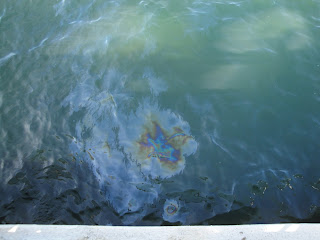 |
| The U.S.S. Arizona Memorial |
In person, its simplicity is perfect. The white stone almost gives off its own light in the Hawaiian sun. There's a constant soft, plumeria-and-salt-water scented breeze and the sound of the water in Pearl Harbor lapping against the Memorial's abutments.
The only way to get to the Memorial itself is to ride a ferry from the Visitor Center to the Memorial. You watch an orientation video before you get on the ferry. The ride gives you a little time to reflect and to get a good look at the outside of the Memorial. It was dedicated in 1962, and in ways, is absolutely a product of its time. Its lines are clean, its shape is simple. It's also timeless. Once I heard the story of the design of it, I didn't see a shoebox anymore when I looked at it.
As you can see, the ends of the Memorial stand tall on the ends and sags in the middle. The Memorial's designer, Alfred Preis, used this shape to represent "initial defeat and ultimate victory." What a message! The openings in the center of the Memorial- there are seven on either side and seven in the roof, twenty-one in all- represent a twenty-one gun salute.
It's impossible to believe in this beautiful, peaceful place that's about as close as we'll get to Paradise here on Earth, hell broke loose on the morning of December 7th, 1941. Once you step onto the Memorial, there's this overwhelming peace, a hush. Yet you can feel the presence of the 1,177 men who died aboard the U.S.S. Arizona that December morning, hovering just over the water of Pearl Harbor, along with those who died aboard other ships that day. The U.S.S. Arizona Memorial is there to honor the memory of all of them.
Although it's popularly believed that the U.S.S. Arizona is still commissioned, that's not correct. What is correct is that the ship's remains are an active military cemetery.
 | |
| The Tears of the Arizona |
But when you're standing on the Memorial, if you stand in the openings and look into the water below, you can see the unmistakable rainbow-tinged swirling black that's oil on the water. Oil from the ship's engines. Ever since December 7, 1941, the U.S.S. Arizona has been weeping oil from her engines. Seventy-one years now, she's been weeping that oil.
These are the Black Tears of the U.S.S. Arizona.
Pearl Harbor legend says that the U.S.S. Arizona will stop weeping her black tears when the last survivor joins his crewmates in death.
 |
| Lest we forget. |
It's a beautiful tribute for the men who served and for those who died on December 7, 1941. Theirs is a brotherhood that only those who have served and survived or served and sacrificed can understand. The rest of us can only wonder about it and be thankful that there are such brave men and women.
Even though we marked Pearl Harbor Day yesterday, it still bears some remembering today and every day. Each day, the clock moves forward. One by one, the crewmen of the U.S.S. Arizona go Home. We'll treasure them while they're here and keep them in our hearts when they're gone.
She'll not weep her Black Tears much longer.
No comments:
Post a Comment